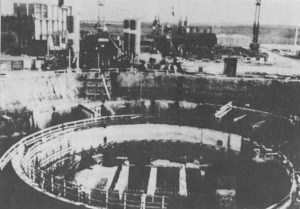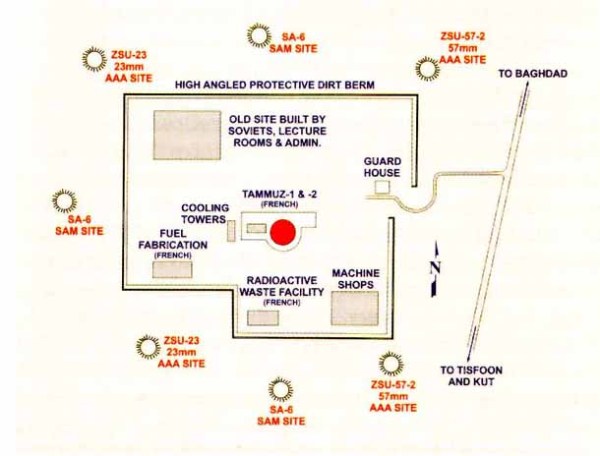Document Friday: When Iran Bombed Iraq’s Nuclear Reactor
Eight days into the Iran-Iraq War, Operation Scorch Sword commenced. At dawn on 30 September 1980, four Iranian F-4E Phantom jets refueled mid-air just before the Iran-Iraq border. After crossing into Iraq, the fighters climbed to a higher altitude so that their course was detectable by Iraqi radar. Moments later, two of the Phantoms peeled off, and dropped to a lower altitude to avoid radar detection. They were flying stealth to Tuwaitha, a city ten miles southeast of Baghdad, home to the Osirak nuclear reactor.
As the world debates the possibility of an Israeli air strike of Iranian nuclear facilities, many have sought to learn lessons from Israel’s 1981 attack on the Osirak reactor. As I thumbed through our documents on Israel’s attack (and boy do we have some good ones), I learned that Iran had bombed Iraq’s nuclear research facility first. And, in all probability, it was Iran’s aerial reconnaissance photographs, which the Islamic republic shared with Israel, that were crucial to the Israeli Air Force’s complete destruction of the reactor on 7 June 1981.
Can’t make this stuff up. Below is a page from the CIA’s 1 October 1980 National Intelligence Daily (NID) that reported the Iranian attack.

Mad Libs on who "confirmed" the strike to the CIA? My bet is on the French Ministry of Foreign Affairs.
According to Tom Cooper and Farzad Bishop of Air Enthusiast, who have written by far the most informative (if unsourced) piece on the subject, Target: Saddam’s Reactor, eye witnesses reported that two bombs hit the dome of the reactor and bounced off. The water cooling facility was also damaged, as were the facilities for storing and treating liquid radioactive waste. Some publications (see the Christian Science Monitor, 22 October 1980) reported that the attack was conducted by Israel. The CIA NID refuted this at the time, and the Air Enthusiast article also factually debunks this claim.
The CIA’s NID downplayed the attack on the nuclear research center, stating “only secondary buildings were hit” and that “neither country’s military capability has been seriously damaged by the other’s air attacks.” Strangely, the Iranian regime also downplayed the attack. One Iranian Air Force pilot even described it as a failure; he was quoted as saying that due to the lack of damage the US-manufactured bombs had inflicted, “we might as well have our planes drop a sack of rocks on the Iraqis.”
Despite the pessimism, the attack did stop the reactor from enriching fissile material. Approximately 400 French scientists, technicians, and engineers had been working on the reactor at the time of the attack left the country in response to the bombing. (France sold Iraq the reactor in 1976.) Enrichment –allegedly for peaceful purposes– stopped and irradiated material was moved to, unconventionally, “underground canals.” The Washington Post reported, that the “worst-case scenario” was that Iraq could create a primitive “dirty bomb (6 November 1980).”
Then, on 30 November 1980, three Iranian Phantoms again entered Iraqi air space. Two entered first, drawing the attention of Iraqi defenders. Soon after, according to Iranian sources quoted by Air Enthusiast, the third –a recon-Phantom– “approached to the south of the target [the Osirak Reactor] at low level, then turned back towards the east and made a single pass over the Osirak reactors while being fired at by several Iraqi AAA and SAM sites. Once out of the target area, the two F-4Es joined up again and escorted the RF-4E safely out of Iraq.” These photographs would lead to the end of Osirak.
On 2 December 1980 –again, if the Iranian accounts can be believed– an unmarked Boeing 707 landed under cover of darkness in Mehrabad Airport, Tehran. There, a crew member was handed “a small metal briefcase, with the instructions ‘Do Not X-Ray’ painted in English on the outside.” Inside, in all likelihood, were the images photographed by Iran and used by the Israeli Air Force in 1981 to conduct Operation Opera, the first successful military destruction of a nuclear reactor.
As an Israeli airstrike on Iranian nuclear facilities continues to loom, Iranians can remember –certainly with some irony–that that their nation was the first to launch an attack on a rival’s nuclear reactor.
Trackbacks
- Document Friday: Can the Fordow Nuclear Enrichment Facility be “Bunker Busted?” « UNREDACTED
- Document Friday: Can Iran’s Fordow Nuclear Enrichment Facility be “Bunker Busted?” « phantasypublishing
- US Documents Help Contextualize Iraqi Records on Iranian Nuclear Program | UNREDACTED
Comments are closed.




have you ever noticed that all the secondary were hit by Iranian and its much harder to draw a circle of fire around the center Iranian only concern was possible radioactive fallout there never been any problem with bombs throughout the 8 years of wars but so soon at the start of the war there were no information available about the extent of possible civilian casualties of possible radio active fallout .this by itself shows Iranian decision making spirit and rationality which later responded by the west inform of providing Saddam with nerve gas and other chemical and biological WMD which not only used against Iranian soldiers but also against Iranian civilian targets in unprotected urban centers. actually Iran lived the responsibility that you can see only in western cover up movies .